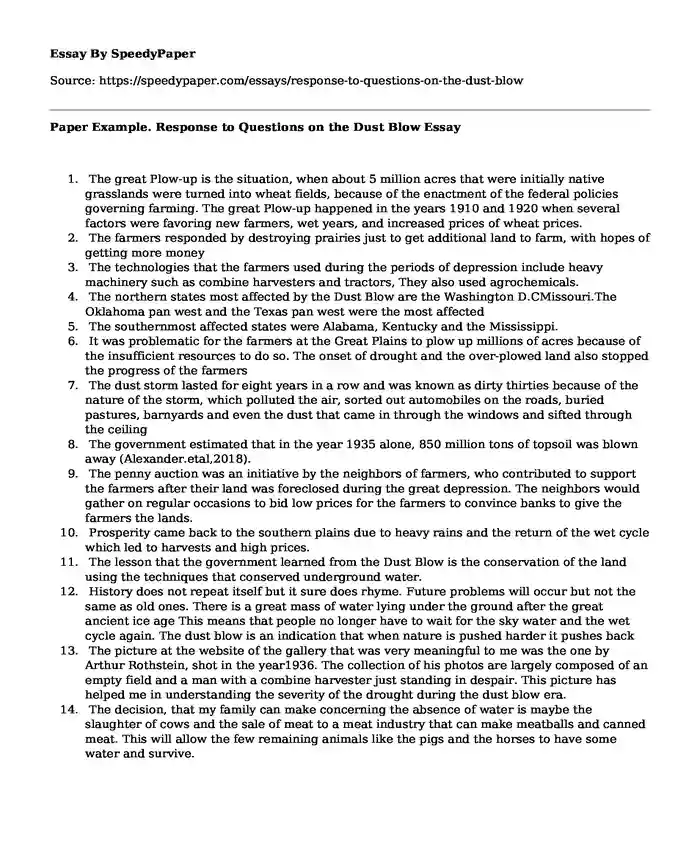
| Type of paper: | Research paper |
| Categories: | Environment Agriculture American history |
| Pages: | 3 |
| Wordcount: | 555 words |
- The great Plow-up is the situation, when about 5 million acres that were initially native grasslands were turned into wheat fields, because of the enactment of the federal policies governing farming. The great Plow-up happened in the years 1910 and 1920 when several factors were favoring new farmers, wet years, and increased prices of wheat prices.
- The farmers responded by destroying prairies just to get additional land to farm, with hopes of getting more money
- The technologies that the farmers used during the periods of depression include heavy machinery such as combine harvesters and tractors, They also used agrochemicals.
- The northern states most affected by the Dust Blow are the Washington D.CMissouri.The Oklahoma pan west and the Texas pan west were the most affected
- The southernmost affected states were Alabama, Kentucky and the Mississippi.
- It was problematic for the farmers at the Great Plains to plow up millions of acres because of the insufficient resources to do so. The onset of drought and the over-plowed land also stopped the progress of the farmers
- The dust storm lasted for eight years in a row and was known as dirty thirties because of the nature of the storm, which polluted the air, sorted out automobiles on the roads, buried pastures, barnyards and even the dust that came in through the windows and sifted through the ceiling
- The government estimated that in the year 1935 alone, 850 million tons of topsoil was blown away (Alexander.etal,2018).
- The penny auction was an initiative by the neighbors of farmers, who contributed to support the farmers after their land was foreclosed during the great depression. The neighbors would gather on regular occasions to bid low prices for the farmers to convince banks to give the farmers the lands.
- Prosperity came back to the southern plains due to heavy rains and the return of the wet cycle which led to harvests and high prices.
- The lesson that the government learned from the Dust Blow is the conservation of the land using the techniques that conserved underground water.
- History does not repeat itself but it sure does rhyme. Future problems will occur but not the same as old ones. There is a great mass of water lying under the ground after the great ancient ice age This means that people no longer have to wait for the sky water and the wet cycle again. The dust blow is an indication that when nature is pushed harder it pushes back
- The picture at the website of the gallery that was very meaningful to me was the one by Arthur Rothstein, shot in the year1936. The collection of his photos are largely composed of an empty field and a man with a combine harvester just standing in despair. This picture has helped me in understanding the severity of the drought during the dust blow era.
- The decision, that my family can make concerning the absence of water is maybe the slaughter of cows and the sale of meat to a meat industry that can make meatballs and canned meat. This will allow the few remaining animals like the pigs and the horses to have some water and survive.
Reference
Alexander, R., Nugent, C., & Nugent, K. (2018). The dust bowl in the US: an analysis based on current environmental and clinical studies. https://www.ncbi.nlm.nih.gov/pubmed/30219167
Cite this page
Paper Example. Response to Questions on the Dust Blow. (2023, Mar 29). Retrieved from https://speedypaper.com/essays/response-to-questions-on-the-dust-blow
Request Removal
If you are the original author of this essay and no longer wish to have it published on the SpeedyPaper website, please click below to request its removal:
- Free Essay: An Academic Challenge I Can Overcome
- Essay Sample with Article Summary on the Current Stand of American Politics
- Epidemiology and Biostatistics Essay Example
- Essay Sample Comparing and Contrasting Two Theoretical Approaches to Counselling
- Free Essay Sample on Florida Law on Domestic Abuse
- Free Essay: An Anthropology Narrative Book Review
- Essay Sample: Theoretical Perspective and the Intervention Phase
Popular categories




